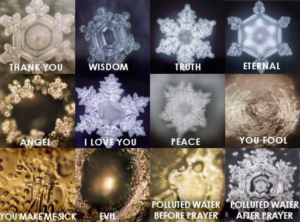The notion of sentient water was developed by Masaru Emoto. He purported to show that when water was treated to varying stimuli, it created noticeably different patterns when it froze into crystals. Water that had been exposed to positive stimuli, such as the word ‘hope’, formed symmetrical, beautiful crystals. Water subjected to negative stimuli such as the expression ‘self-consciousness’, formed misshapen crystals. Emoto’s claim was that water could sense the emotions behind the words, and would respond accordingly.

Emoto produced a large number of photographs of his experiments, which seemed to support his claim. Water exposed to pleasant or positive emotions showed beautiful crystals. The negative emotions led to distorted and unpleasing crystals. It seemed as though water had some sort of sentience, could feel and respond to emotions.
While this is an exciting idea, it has not been supported. Other workers have not been able to reproduce Emoto’s results. This is a serious problem with a new hypothesis. If only the original experimenter can produce the results he claims, it is strong evidence that the effect is spurious. That can point to fraud or experimental errors. To my knowledge, Mr. Emoto has not been accused of fraud. However, several workers suggest that Emoto’s techniques might have been such that they accidentally introduced errors.
When a scientist’s experiments cannot be replicated, the claims of the scientist cannot be accepted as valid. One major tenet of the Scientific Method is repeatability. Otherwise, it’s just a fluke, a dead end.
Emoto’s experiments received widespread attention and acceptance, because many people liked the idea that the Universe responds to our thoughts, words, energy. Say nice things, water makes pretty crystals. It’s a pleasant though. However, there is no evidence to support Emoto’s hypothesis or his conclusions.
